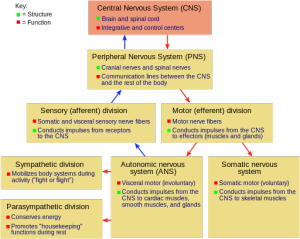The human nervous system gathers information, processes that information, and then initiates a response.
There are several divisions of the nervous system, well laid out in the graph above.
If you search divisions of the nervous systems under Google images you are provided with an endless array of graphs like the one I posted, all with slightly different approaches to the same puzzle. You can learn a lot simply by looking at a handful of them.
Divisions of the Nervous System
The nervous system is initially divided into the central nervous system and the peripheral nervous system.
The central nervous system (CNS) has two parts, the brain and the spinal cord.
The peripheral nervous system is all of the nerves that emanate from the spinal cord to the rest of the body and is divided into the somatic nervous system and the autonomic nervous system.
Within the somatic nervous system sensory nerves send information to the brain.
They sense a stimulus such as something hot and send that information to the brain. Motor nerves exit the brain with the response plan for the stimulus received (like moving a hand away from a flame). The somatic nervous system controls the body’s voluntary movements.
The autonomic nervous system controls the involuntary movements that the body makes, such as sweating or digesting, and there are three divisions within the sympathetic nervous system, the parasympathetic nervous system and the enteric nervous system.
The sympathetic nervous system and the parasympathetic nervous system work together and separately to maintain balance, or homeostasis, within the body.
The sympathetic nervous system is related to your flight or fight system.
The way I always remembered it is that the sympathetic nervous system is in “sympathy” with your stress and mobilizes the body to react.
The parasympathetic nervous system relates to relaxation or quiet and is often working in concert with the sympathetic nervous system to maintain equilibrium.
This elusive equilibrium is what I am most often working with when trying to help people find their way out of pain and poorly conditioned movement patterns.
We can learn to ease the nervous system out of a state of constant tension and into an environment of ease, and in turn change our outlook on the world.
Pain colors our perceptions and a lack of pain can offer freedom to our body, mind, and spirit. And as always, I believe that learning how the body works and coming to an understanding of the divisions of the nervous system can help us process the journey we are taking in a more efficient manner.
***

